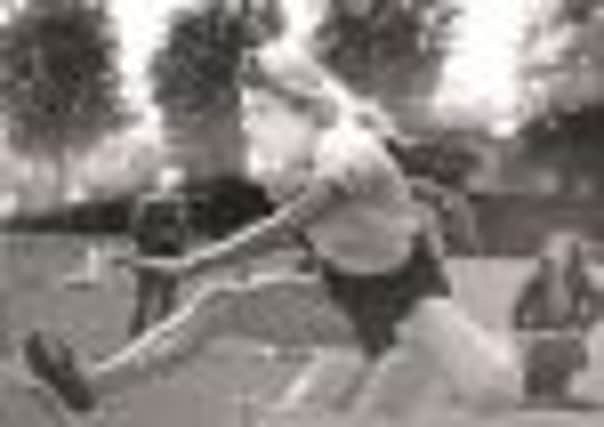Obituary: Dr Quita Barber, anaesthetist and Olympic runner


She once joked that she never needed anything stronger than an extra sugar lump in her tea to boost her performance – the young sprinter had a natural talent that gave her wings.
Quita Shivas, as she was then known, had won every school sports race as a child but only really began to blossom in athletics as a result of a dare – her brother challenged her to race her taller, fellow university students and the 5ft 3in dynamo beat the field.
Advertisement
Hide AdAdvertisement
Hide AdFrom then on she won every university event she entered, became one of Britain’s most accomplished young runners and the country’s first woman doctor to run in the Olympics.
While studying medicine at Aberdeen University she took the British 60m sprint champion’s crown, then collected a gold medal at the World Student Games before representing Great Britain in the Helsinki Olympics and going on to balance the twin challenges motherhood and medicine.
Born into a well-known Aberdeen family, she was the daughter of Andrew Shivas, a chartered accountant, part-time ventriloquist, magician and a founder member of the Aberdeen Magical Society, and his wife Blanche.
Christened Isabella, she was nicknamed Quita, after the song Marquita, sung to her as a baby by her mother.
She attended Aberdeen High School for Girls and, as a teenager during the Second World War, regularly went firewatching, looking out for German bombers, often being forced to flee into air raid shelters as the city came under a number of destructive enemy attacks.
After leaving school she worked in Aberdeen University’s pathology department before following her brother Andrew there, as a medical student, in 1946. Popular and easy-going, with a great sense of humour, she began to develop her athletics career in tandem with her studies and was always the life and soul of the party when the teams travelled to inter-university athletic events.
A sprinter and hurdler, her main events were the 60m and 100yd sprints and 80m hurdles, though she also ran the 200/220yd events.
A member of the university’s athletics, hockey and golf clubs, she gained an athletics full blue in 1946 and was vice president of Aberdeen University Athletic Association in 1949-50. She was also in the Scottish University Athletic Union for several years and its woman’s captain in 1949.
Advertisement
Hide AdAdvertisement
Hide AdDescribed by one university friend as having quite a slap dash attitude and doing very little training – “she just turned up on the day and beat everyone” – she became an outstanding but modest sportswoman.
Her medal haul included silver in the 200yds at the 1947 Paris World Student Games; gold in the 100yds and bronze in the 80m hurdles at the same event four years later in Luxemburg.
In 1950 she won the 60m sprint at the British Women’s Amateur Athletic Association championships at London’s White City, to become British champion.
As a student she also set a new inter-university record and equalled the Scottish all- comers’ record, set by renowned Dutch Olympian Fanny Blankers-Koen, with a time of 11.2sec in the 100yds. In the 80m hurdles she created a new record of 12.2sec.
She graduated MB ChB from Aberdeen in 1951 and moved to London to pursue her athletics career, joining Spartan Ladies Athletics Club while working at Hammersmith Hospital. She raced regularly at White City and was a winner on the circuits and at UK athletic meets before fulfilling her ambition, in 1952, to be selected to represent Britain in the 100yds at the Helsinki Olympics.
She set off, armed with her lucky cork from her graduation party Champagne, and came third in her heat. She was later honoured with a civic reception in Aberdeen where she was awarded silver medallion in recognition of her achievements.
Reaching the Olympics was all she had every wanted and she was then happy to retire from athletics to concentrate on medicine. She completed her post-graduate training in various places including Royal Aberdeen Children’s Hospital, Stracathro and Raigmore in Inverness but also thoroughly enjoyed a period at Insch, in rural Aberdeenshire, during her GP training.
She qualified as an anaesthetist in 1956 and practised in Inverness for four years before working in Bangour, Livingston and Haddington while based at Edinburgh Royal Infirmary. She was living in the capital when she met her future husband, Stuart Barber, a forestry consultant.
Advertisement
Hide AdAdvertisement
Hide AdThey married in Aberdeen in 1963 and lived in Edinburgh but, within a couple of years and following the birth of their daughter Judith, they moved to Newstead, near Melrose, where they spent the rest of their married life.
There she successfully combined motherhood with a career in anaesthetics, working part-time at Borders hospitals including Peel near Galashiels and Dingleton in Melrose.
As in her student days, she was a well-liked, bright and uplifting figure, a very capable professional whose natural compassion put patients at their ease.
After retiring in her mid-50s she continued her interest in athletics, closely monitoring Commonwealth and Olympic games via television.
Interviewed for her local paper around the time of the 1992 Barcelona Olympics, she reminisced about the Helsinki Games and discussed her concerns over doping in athletics, giving rise to her quip about extra sugar.
Well known in the town, she was delighted to be asked to open a branch of Boots the Chemist in Melrose in 2007. The following year she visited Aberdeen for the last time, calling in at the university playing fields where she first made her mark and proving she was still nimble enough to get down on her marks at the start of the 100yds.
She is survived by her husband Stuart, daughter Judith, nieces, nephew and great niece.
ALISON SHAW